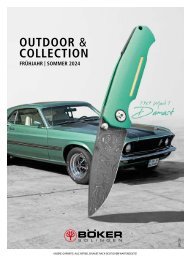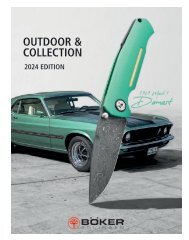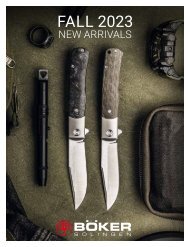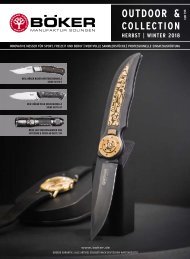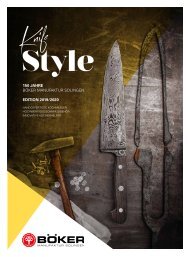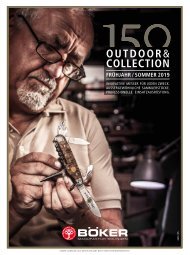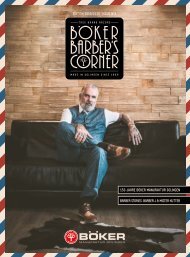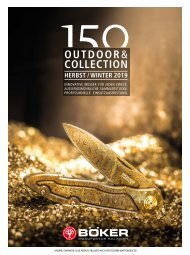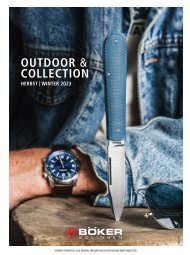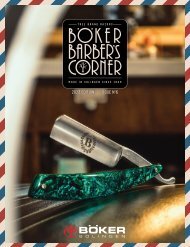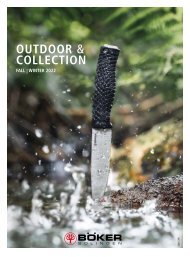Boker Barbers Corner | BUSA Edition 2020
You also want an ePaper? Increase the reach of your titles
YUMPU automatically turns print PDFs into web optimized ePapers that Google loves.
BÖKER MANUFAKTUR SOLINGEN<br />
37<br />
CARE & STROPPING OF STRAIGHT RAZORS<br />
Caring for a straight razor mainly<br />
entails preserving the razor's edge<br />
and protecting it from corrosion.<br />
The sharpness of the razor mainly<br />
comes from regular "stropping" on<br />
linen and untreated leather and,<br />
after a while, on leather treated<br />
with a grinding paste. This requires<br />
a bit of practice but can be learned<br />
quickly. While with a pocket or<br />
kitchen knife, the difficulty lies in<br />
maintaining the correct angle, the<br />
geometry of the straight razor helps<br />
us a lot in this respect. The precisely<br />
balanced ratio of the very thick back<br />
of the blade to the whisper-thin<br />
edge ensures that you automatically<br />
get the right angle on the edge<br />
when the back touches the leather<br />
strop (see fig. 1).<br />
SPINE<br />
LEATHER<br />
Fig. 1<br />
BLADE<br />
First, touch the back to the leather<br />
and then carefully move the edge<br />
to touch the strop. Now pull the<br />
straight razor with slight pressure in<br />
the direction of the back (away from<br />
the edge) across the entire length<br />
of the strop. While doing so, move<br />
the razor slightly diagonally across<br />
the leather. This way you can cover<br />
the entire length of the edge with<br />
the leather. The back and the edge<br />
must be in constant contact with<br />
the strop (see fig. 2).<br />
Fig. 2<br />
It is very important to flip the razor<br />
over its back when you reach the<br />
end of the strop. UNDER NO<br />
CIRCUMSTANCE should you flip<br />
the straight razor over the edge –<br />
this would round off the edge again,<br />
i.e. blunt it (see fig. 3).<br />
Fig. 3<br />
The untreated leather does not<br />
remove material from the edge, i.e.,<br />
it does not sharpen the razor in the<br />
usual sense. You can image the<br />
burr of the edge microscopically like<br />
a comb whose teeth are bent in all<br />
directions after shaving. The strop<br />
realigns these teeth into an even<br />
burr. If available, one should use<br />
the linen side in exactly the same<br />
manner as the leather strop before<br />
stropping.<br />
The fiber of the linen is soft, the<br />
mesh of the textile, however, is<br />
rough. This allows the linen to grip<br />
the burr and align it. The weave of<br />
the textile catches dirt and loose<br />
steel particles which could damage<br />
the sensitive edge when pressed<br />
against the strop. The final use of the<br />
strop makes the resulting edge finer.<br />
You should strop the razor BEFORE,<br />
and not AFTER shaving. Steel has<br />
a certain level of self-healing power,<br />
or “memory.” After stress, the burr<br />
slowly and partially stands itself up<br />
again. If you violently rip the burr<br />
up with the strop immediately after<br />
shaving, this stresses the material,<br />
which shortens the life expectancy<br />
of the burr and, in the long run, of<br />
the razor. The razor should rest for<br />
at least 24 hours after the shave<br />
– but 48 hours or more is ideal,<br />
so if you shave every day, you<br />
should own at least two straight<br />
razors. Our grandfathers therefore<br />
often had sets for the entire week,<br />
containing 7 razors.<br />
If the cutting performance of the<br />
razor decreases over time despite<br />
regular stropping, the razor should<br />
be stropped on a second strop<br />
treated with special red grinding<br />
paste. This process actually does<br />
remove a minute amount of steel<br />
from the blade. It is not that easy<br />
to answer the obvious question of<br />
after how many shaves this should<br />
be done, as every beard is different.<br />
Many men only shave partially and<br />
contour their beards – the stress on<br />
the blade is different in each case.<br />
The user should strop with paste<br />
when the razor begins to pinch<br />
when shaving.<br />
After stropping with paste, you<br />
should clean the blade thoroughly,<br />
and strop it once more on untreated<br />
leather. In order to protect it from<br />
corrosion, dry the blade carefully<br />
and thoroughly after shaving, and<br />
then oil it with an acid-free, viscous<br />
oil. Camellia oil has proven to be<br />
excellent for this purpose (see page<br />
36).




